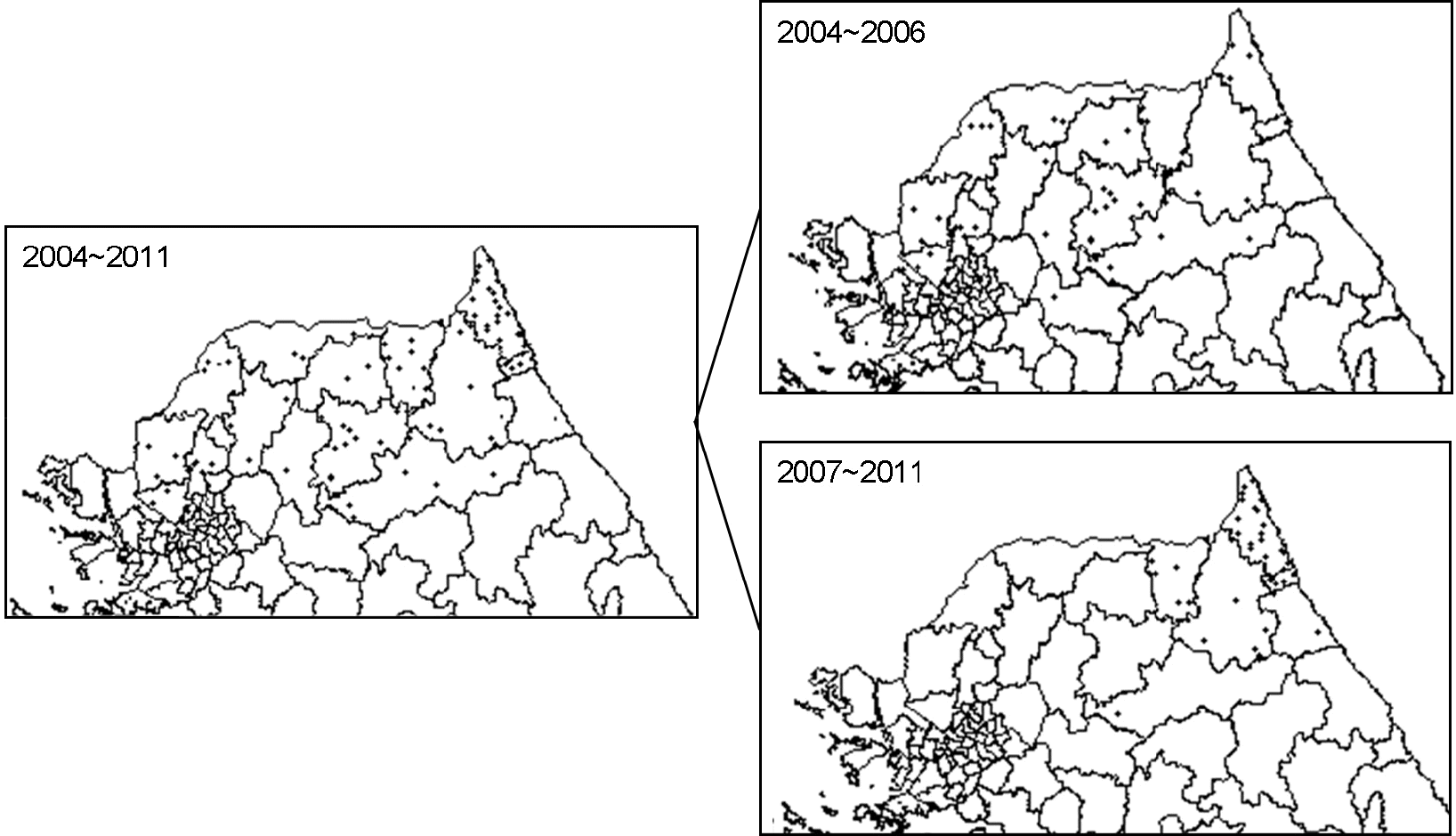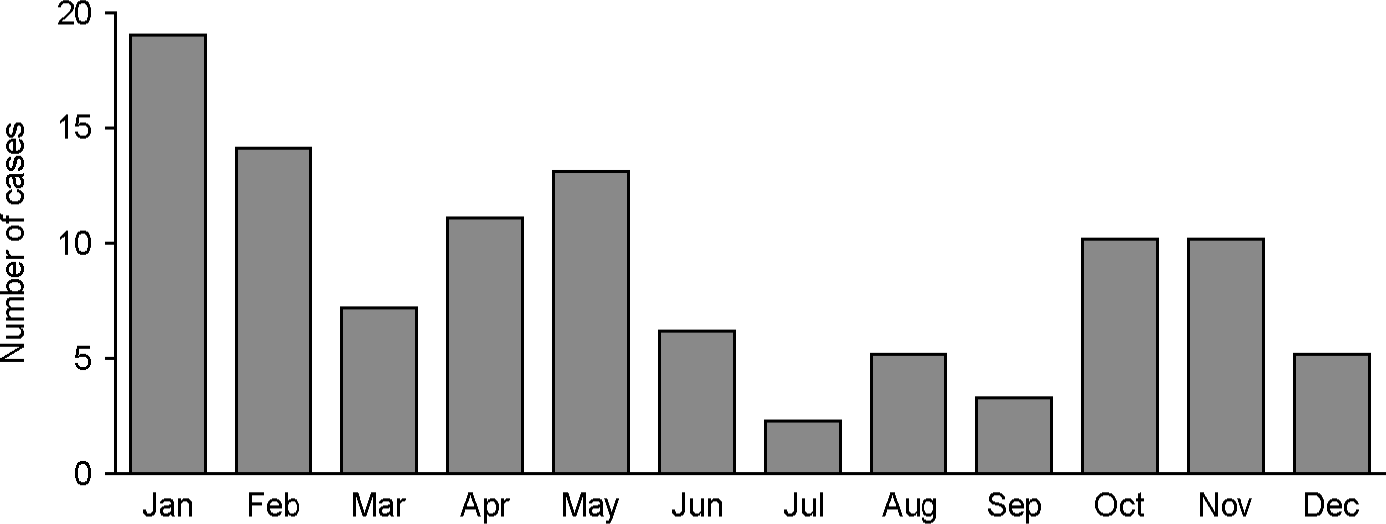Abstract
Over the seven years from January 2004 to March 2011, 105 rabies cases in three different animal species and one case in human were recorded in South Korea. Forty three (40.6%) cattle and 33 (31.1%) dogs, 29 (27.4%) raccoon dogs were affected and one (0.9%) death in human was reported. The highest annual incidence of rabies was recorded with 27 cases in 2004, and then decreased to a median of 14 cases per year. Eighty cases (76.2%) occurred in Gangwon and 24 cases (22.9%) in Gyeonggi and one case in Seoul Province. All rabies cases occurred in the northern part of the country, namely, Seoul, Gyeonggi and Gangwon Provinces. Since 2007, rabies cases were not reported in Gyeonggi Province, but continued to occur and move eastward in Gangwon Province. The monthly distribution of animal rabies during the seven year period peaked in January, and the incidence was the highest during winter, from December to February, and the least common in summer, from June to September. The epidemiological study indicated that preventive measures including distribution of bait vaccine for the control of rabies in wild animals was helpful to a substantial decrease in number of rabies cases in South Korea.
Go to : 
REFERENCES
1). World Health Organization (WHO). WHO expert committee on Rabies. World Health Organ Tech Rep Ser. 1992. 824:1–84.
2). Tordo N., Bahloul C., Jacob Y., Jallet C., Perrin P., Badrane H. Rabies: epidemiological tendencies and control tools. Dev Biol (Basel). 2006. 125:3–13.
3). Lee JB., Lee HJ., Hyun BH., Bang JH., Nam KO., Jeong YE, et al. Epidemiology and prevention strategies of rabies in Korea. Korean J Epidemiol. 2005. 27:53–68.
4). Park YJ., Shin MK., Kwon HM. Genetic characterization of rabies virus isolates in Korea. Virus Genes. 2005. 30:341–7.

5). Kim CH., Lee CG., Yoon HC., Nam HM., Park CK., Lee JC, et al. Rabies, an emerging disease in Korea. J Vet Med B Infect Dis Vet Public Health. 2006. 53:111–5.

6). Kim JH., Hwang EK., Sohn HJ., Kim DY., So BJ., Jean YH. Epidemiological characteristics of rabies in South Korea from 1993 to 2001. Vet Rec. 2005. 157:53–6.

7). Hyun BH., Lee KK., Kim IJ., Lee KW., Park HJ., Lee OS, et al. Molecular epidemiology of rabies virus isolates from South Korea. Virus Res. 2005. 114:113–25.

8). Yang DK., Park YN., Hong GS., Kang HK., Oh YI., Cho SD, et al. Molecular characterization of Korean rabies virus isolates. J Vet Sci. 2011. 12:57–63.

9). Office International des Epizooties (OIE). Manual of Diagnostic Tests and Vaccines for Terrestrial Animals. Rabies, 6th ed. Paris: Office Intl Des Epizooties. 2008. 304–22.
10). Strano AJ. Light microscopy of selected viral diseases (morphology of viral inclusion bodies). Pathol Annu. 1976. 11:53–75.
11). Coertse J., Weyer J., Nel LH., Markotter W. Improved PCR methods for detection of African rabies and rabies-related lyssaviruses. J Clin Microbiol. 2010. 48:3949–55.

12). Holmes EC., Woelk CH., Kassis R., Bourhy H. Genetic constraints and the adaptive evolution of rabies virus in nature. Virology. 2002. 292:247–57.

13). The TH., Feltkamp TE. Conjugation of fluorescein isothiocyanate to antibodies. I. Experiments on the conditions of conjugation. Immunology. 1970. 18:865–73.
14). Eo KY., Kwon OD., Shin NS., Shin T., Kwak D. Sarcoptic mange in wild raccoon dogs (Nyctereutes procyonoides) in Korea. J Zoo Wildl Med. 2008. 39:671–3.

15). Yang DK., Yoon SS., Lee KK., Byun JW., Bae YC., Oh YI, et al. Rabies immune status in the stray and companion dogs in Korea. Korean J Vet Res. 2010. 50:133–7.
16). Ernst SN., Fabrega F. A time series analysis of the rabies control programme in Chile. Epidemiol Infect. 1989. 103:651–7.

17). Corn JL., Méndez JR., Catalán EE. Evaluation of baits for delivery of rabies vaccine to dogs in Guatemala. Am J Trop Med Hyg. 2003. 69:155–8.
18). Shao XQ., Yan XJ., Luo GL., Zhang HL., Chai XL., Wang FX, et al. Genetic evidence for domestic raccoon dog rabies caused by Arctic-like rabies virus in Inner Mongolia, China. Epidemiol Infect. 2011. 139:629–35.

19). Lee SH., Koh IS., Kwon HK., Kang JW., Cho PZ. A case of human rabies confirmed by polymerase chain reaction. J Korean Neurol Assoc. 2002. 20:437–8.
20). Bourhy H., Kissi B., Audry L., Smreczak M., Sadkowska-Todys M., Kulonen K, et al. Ecology and evolution of rabies virus in Europe. J Gen Virol. 1999. 80:2545–57.

21). Hwang EK. Outbreak and control of rabies in animals in Korea: a review. Kor J Vet Public Health. 1995. 19:281–93.
Go to : 
 | Figure 1.Distribution of rabies cases in South Korea from January 2004 to March 2011. A dot indicates the site of the incidence of rabies. It is notable that the disease outbreaks continued to move to the eastern part of Gangwon Province between 2007 and 2011. |
 | Figure 2.Change of rabies incidences in Gyeonggi and Gangwon Province. The rabies incidence was significantly decreased in Gyeonggi Province (A). In Gangwon Province, the rabies cases were decreased and the outbreak regions were moved into the eastern part (B). |
 | Figure 3.Total monthly distribution of animal rabies cases in South Korea from January 2004 to March 2011. |
Table 1.
Reported rabies cases in human and animals in South Korea from January 2004 to March 2011
Table 2.
Number of animal rabies recorded in Seoul, Gyeonggi and Gangwon Provinces from January 2004 to March 2011




 PDF
PDF ePub
ePub Citation
Citation Print
Print


 XML Download
XML Download